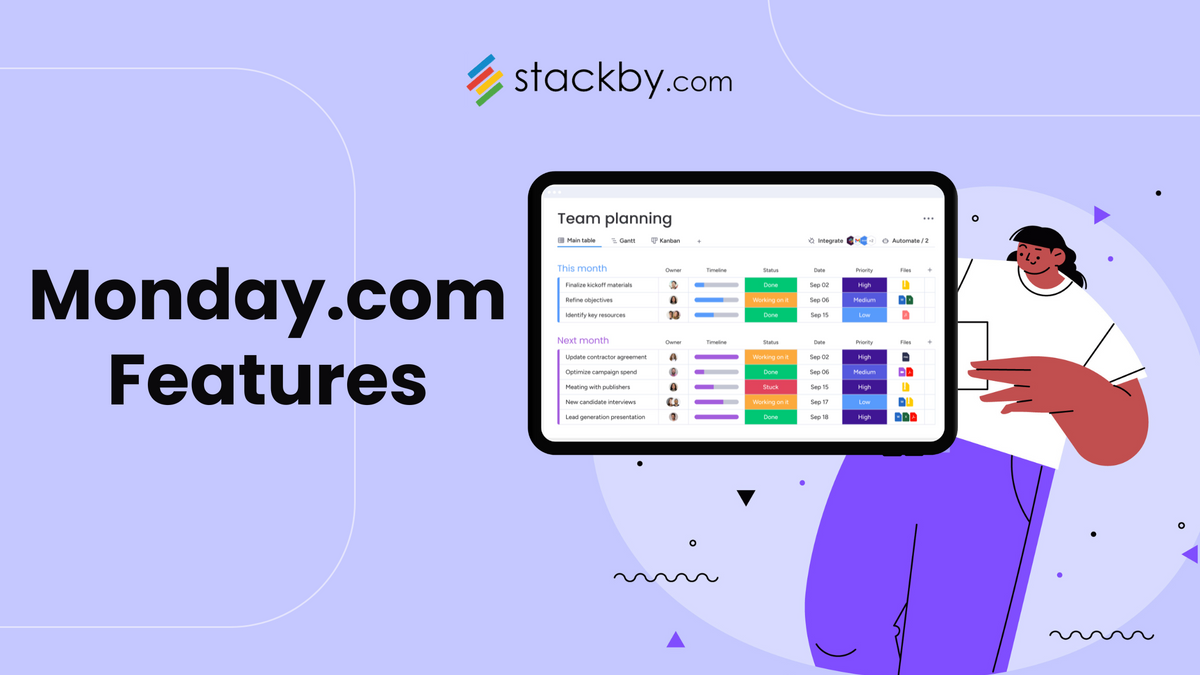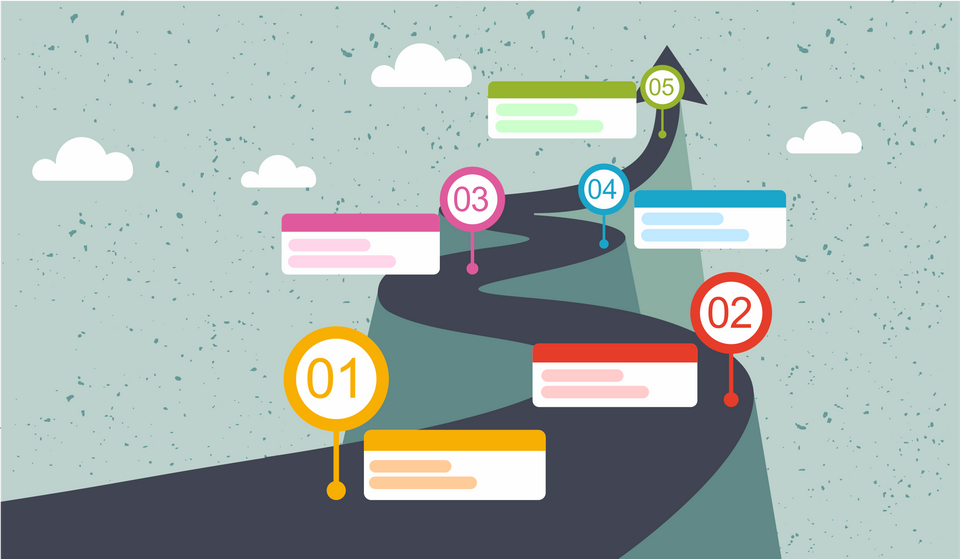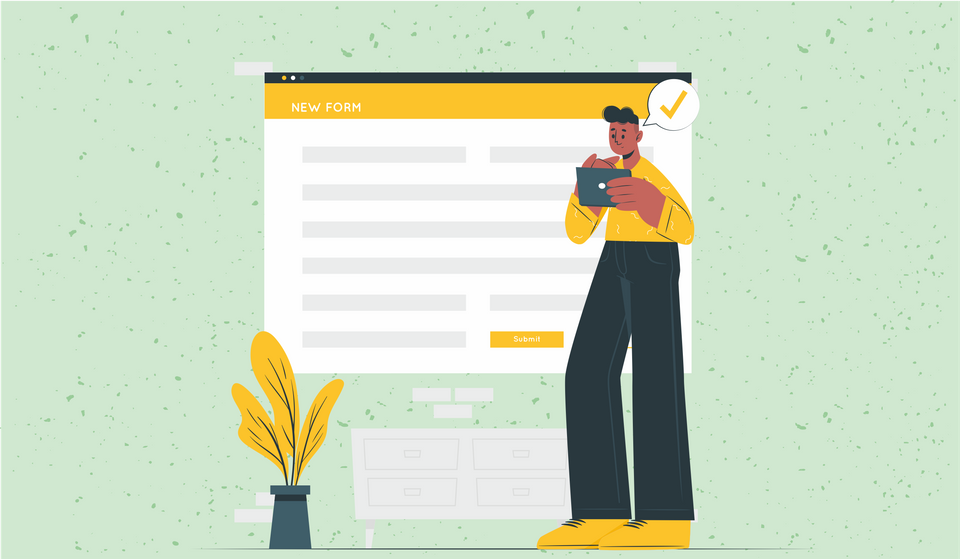Monday.com Features in 2025: A Deep Dive into Its Capabilities
Monday.com’s 2025 update brings more than just task management. From dynamic boards to powerful CRM, automations, and AI, we break it all down—and show how Stackby stands tall as a flexible, affordable alternative for teams looking beyond the mainstream.

Let’s be honest: the world doesn’t need another project management tool blog. We all know the drill. Boards, tasks, timelines, automations. Yawn.
But here's the thing. When you're knee-deep in juggling tasks, automating workflows, or pulling reports at 10 PM on a Friday, the tool you're using either makes life easier, or gives you a full-blown existential crisis. That’s when you realize: features matter. Not on paper. In practice.
So let’s cut through the marketing gloss and get into what Monday.com actually offers in 2025, the good, the maybe-not-so-good, and how Stackby quietly stands tall next to it.
What is Monday.com?
Monday.com is a cloud-based Work OS, a flexible platform where teams can plan, organize, and manage just about anything. Sure, it started as a project management tool, but it’s grown way beyond that.
It’s not just a single tool. The Monday.com ecosystem has expanded over the years, and in 2025, it includes several specialized products:
- Monday WorkOS - The core platform, powering task management, workflows, and team collaboration.
- Monday CRM - A customizable CRM solution to manage sales and customer relationships.
- Monday Projects - Focused on project planning, timelines, and resource management.
- Monday Dev - Built for product and development teams with agile tools.
With over 245,000 customers worldwide, spanning public companies, agencies, educational institutions, and more, Monday.com has cemented itself as a powerhouse in the work management space. It’s modular, which means you can shape it around your needs, whether you're organizing a creative team, managing client pipelines, running complex product launches, or just keeping your own team’s chaos in check.
Key Features of Monday.com
Visual Boards With Multiple Views
At the heart of Monday.com is the board, which acts as the central hub for all your work. You start with a blank board and build from there by adding different column types or choose from 200+ pre-built templates. `
It also offers multiple views. You can switch between views like Kanban, Calendar, Timeline, Gantt, and Workload. Kanban is great for task tracking, Gantt shows task dependencies in a timeline, and Calendar keeps your deadlines visible. Want a bird’s-eye view of tasks across your team? That’s where Workload comes in, showing who’s drowning in tasks and who’s chilling.
Customizable Workflows
Its drag-and-drop workflow builder lets you design processes. Want a task to move from ‘To Do’ to ‘In Progress’ with one click? Done. Need a notification when a task is complete? Easy.
Automations
Monday lets you build automations using "If this, then that" logic. Users can set up custom triggers and actions and automate repetitive stuff like assigning tasks, sending emails, or changing statuses.
But, and there’s a but, automations are tied to your pricing plan. And the limits on monthly automation runs? They can hit you fast if your team is doing a lot.
Dashboards & Reporting
The platform's dashboards consolidate data from multiple boards, presenting key metrics and insights in one place. You’ve got widgets for charts, numbers, time tracking, and more. So instead of hunting down data, you just look at your dashboard.
Docs, Whiteboards, and WorkForms
Monday Docs now comes with real-time collaboration, embeds, and connected boards. There's also Monday WorkForms, which feels like a Google Forms alternative, only way more tied to workflows. And whiteboards are perfect for brainstorming without any structure.
Collaboration Tools
Monday.com enhances team collaboration through features like real-time updates, mentions, file sharing, and comment threads. These tools ensure that communication remains seamless and everything stays right where the work is.
Monday AI
Monday AI can automate updates, generate task descriptions, and even suggest next steps. It’s smart, but still learning. Want it to draft a task list based on your project goals? Done. Need it to analyze team performance? Maybe not perfect yet, but getting there.
Integrations Marketplace
The platform supports over 200 integrations, including popular tools like Slack, Google Drive, Zoom, and Salesforce. This extensive integration capability allows teams to connect their existing tools and streamline workflows.
Time Tracking & Workload Management
With built-in time tracking features, you can monitor the time spent on tasks. It's perfect for teams that bill by the hour or just want to see where time goes.
While workload management tools help allocate resources effectively, preventing burnout and ensuring balanced workloads.
Baselines and Milestones
Baselines help you track project progress against the initial plan—did you finish on time, or did things spiral? Milestones mark major stages or achievements, keeping your team aligned on what really matters.
Mobile and Desktop Apps
With dedicated apps for iOS, Android, Windows, and Mac, Monday.com ensures that teams can access their work from anywhere, maintaining productivity on the go.
Monday.com Work Platform Pricing Tiers (2025)
Monday.com CRM Platform Pricing Tiers (2025)
Monday.com offers a variety of products, each with its own pricing model. Beyond the core MondayOS (Work Operating System), they have tailored solutions for specific departments. This includes Monday CRM for managing customer relationships, Monday Dev for software development teams, and Monday IT & Support for handling IT tasks and customer support workflows. Each of these products is priced individually to cater to the distinct needs of different teams within an organization.
Now, focusing specifically on the Monday CRM platform, here’s the breakdown of its pricing tiers:
- Free Plan: Ideal for individuals or small teams, this plan allows up to 2 users with basic CRM functionalities.
- Basic Plan: Priced at $12 per user per month (billed annually), this plan includes unlimited customizable pipelines, unlimited contacts, and access to iOS & Android apps.
- Standard Plan: At $17 per user per month (billed annually), it offers all features of the Basic plan plus advanced account, contact, and deal management, 2-way email integration with Gmail and Outlook, and HIPAA compliance.
- Pro Plan: For $28 per user per month (billed annually), this tier includes all Standard features along with sales forecasting, mass emails, and email automations.
- Enterprise Plan: Custom pricing tailored for large organizations requiring advanced features like lead scoring, advanced analytics, and enterprise-scale automations.
Who Is Monday.com Best For?
Monday.com is ideal for:
- Mid-sized to large teams seeking structured workflows and centralized project tracking.
- Project managers, marketing teams, HR departments, sales & CRM teams, software/product teams requiring customizable workflows and integrations.
- Industries such as tech, creative agencies, real estate, manufacturing, HR/recruitment, consulting, and construction.
But if you’re a small team or a startup trying to move fast and test things? Or you want to build workflows around APIs, data, and external tools? That’s where you might hit a wall.
Limitations of Monday.com
While Monday.com offers a robust platform, there are some limitations to consider:
- Just a free trial, pay after 14 days: You can only use it for 14 days and then go behind a paywall to access the product..
- Expensive Scaling: As your team grows, the cost multiplies because it’s per user. A small team might be okay, but a big team? It adds up quickly.
- Confusing Pricing Tiers: Plans are offered in predefined user groups (3, 5, 10, 15, 20, etc.). This means a team of 4 pays for 5 users, and a team of 7 pays for 10. It’s frustrating for smaller teams with tight budgets.
- Feature Access: Some functionalities, like time tracking and workload views, are only available in higher-tier plans.
- Complexity for New Users: The platform is powerful but can be overwhelming for beginners. Customization is great, until you have no idea where to start.
- Automation Limits: Depending on your plan, you get a cap on the number of automation runs per month. If your team’s heavy on automation, you might max out fast.
- Limited Customization for Low Tiers: Some powerful features are locked behind higher-tier plans.
- Inconsistent Customer Support: Users have reported slow response times and unresolved issues. For a premium-priced tool, that can be a big letdown.
- Bugs and Technical Glitches: Despite being a mature tool, bugs pop up now and then, affecting user experience, especially when working on complex automations.
How Stackby Compares
Stackby is steadily becoming a stronger alternative to Monday.com. It’s not just another project management tool, it’s a hybrid of a spreadsheet, a database, and a workflow builder. And it’s growing fast.
In 2025, Stackby isn’t just about task tracking or data storage, it’s a platform that lets you build dynamic solutions, automate repetitive work, and manage complex data, all in one place.
Whether you're a startup building CRM systems, a digital agency tracking clients, or an e-commerce brand automating orders, Stackby has a setup that can fit you. With its flexible pricing, ever-expanding App Marketplace, 1000+ pre built templates, and 50+ API integrations, it’s not just catching up, it’s setting its own pace.
Here’s where it really starts to stand out in 2025
Key Features of Stackby
Relational Database Meets Spreadsheet
Create tables that behave like databases, but feel like spreadsheets. Link records across tables. Use advanced column types. Run formulas. Lookups. Buttons. Its Grid view can look like a spreadsheet but with way more muscle.
Views Galore
Stackby offers multiple view options to help you visualize your data exactly how you want.
- Grid View: Your classic spreadsheet look, perfect for data-heavy setups.
- Kanban View: Great for task management and workflow tracking, with customizable columns.
- Calendar View: Plan events, tasks, and deadlines at a glance.
- Gallery View: Showcase images, portfolios, or visual data beautifully.
- Timeline View: Perfect for project planning, seeing tasks spread across time.
- List View: A clean, linear view of your tasks or items for simple tracking.
Diverse Column Types
With over 30 column types, including attachments, dropdowns, formulas, buttons, and lookups, Stackby allows for detailed data structuring tailored to specific requirements.
Forms and Updatable Forms
Create forms to collect data directly into your tables, and with updatable forms, let your users update the data they submitted without disrupting the workflow.
Built-In Automations + API Connectors
You can set internal automations, and with newer 2025 updates, tie column data directly to external APIs, in real time.
Fetch YouTube analytics, Mailchimp subscriber counts, Shopify orders, all in your tables.
Powerups
Stackby offers a growing ecosystem with 30+ Powerups, enhancing its functionality. These Powerups include tools like the Two-Column Layout in forms for better data visualization, Signature Capture for forms, and other powerful features like column permissions, Airtable auto importer. With more Powerups continuously being added, users can expect even more flexibility to customize their workflows and boost productivity.
App Marketplace
Stackby offers a growing collection of in-built apps to supercharge your experience. From the Charts app, where you can visualize data with different chart types and graphs, to Pivot Tables for dynamic data analysis, there’s plenty to explore. You also get Maps, which lets you plot data for location-based insights, Countdown Tracker to stay on top of deadlines, and Time Tracker to monitor productivity. And these are just a few examples from the many apps we have, with even more on the way.
1000+ Pre Built Database Templates
Stackby’s extensive template library covers almost every use case you can think of. Whether it’s a marketing team planning campaigns, sales teams tracking leads, educators managing student data, or e-commerce businesses managing products, Stackby has you covered. From event planning and hospitality to healthcare and even Shopify order tracking, there’s a template for everyone.
Secure and Scalable
With enterprise-grade security, user permission controls, and scalable infrastructure, Stackby is designed to grow with you.
Flexible Pricing Plans
Stackby offers team-based pricing and one-time lifetime plans, making it a budget-friendly option for organizations of all sizes. Whether you’re a freelancer just getting started or a fast-scaling business, there’s a plan that fits.
Feature Comparison: Monday.com vs. Stackby
Final Thoughts: Which One Should You Go For?
Honestly? It depends on your style.
Monday.com is fantastic if you love structure. If your workflows are set and you want your team to plug into a system without reinventing the wheel, it’ll get the job done, beautifully even. But there are limits. And those limits can be frustrating, especially when you're trying to build something a little different.
Stackby, on the other hand, gives you the canvas. You're not just managing tasks, you're building systems. Real ones. That fetch data, transform it, automate it, and scale with you. And you don’t have to upgrade every time you want an extra button.
So yeah. If you’re tired of rigid workflows and overpriced upgrades, maybe it’s time to explore a new stack.
Want to try Stackby and build your own workflows? Explore templates or start for free.



![13 Best Business Management Software for your Work [2025]](/blog/content/images/size/w960/2024/03/stackby-business-blog-image-1.jpg)
